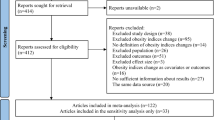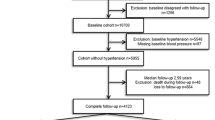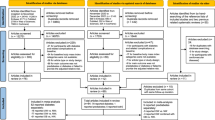Abstract
Despite the established relationship of obesity to hypertension, the question as to whether there is a linear association between these two morbidities is unanswered. To quantitatively evaluate the relationship between obesity and hypertension, we carried out a dose–response meta-analysis of studies that looked at the relationship of different adiposity measures to hypertension. We searched PubMed, Embase, and Web of Science databases for articles published before 27 June 2017. A random-effects model was used to pool relative risks and 95% confidence intervals. Restricted cubic spline analysis was used to model the relationship. A total of 59 studies were included. Fifty-seven cohort studies with 125,071 incident cases among 830,685 participants were included in the analysis of body mass index and hypertension with the summary relative risk for per 5-unit increment in body mass index of 1.50 (95% confidence interval: 1.40–1.59). We found that the risk of hypertension in the body mass index analysis was greater in populations where the baseline body mass index was <25 kg/m2. The summary relative risk for a 10-cm increase in waist circumference was 1.25 (95% confidence interval: 1.19–1.32) and per 0.1-unit increase in waist-to-hip ratio was 1.27 (95% confidence interval: 1.18–1.37). This meta-analysis suggests that in normal range of obesity indexes, as lean as possible may be the best suggestion to prevent hypertension incidence.
This is a preview of subscription content, access via your institution
Access options
Subscribe to this journal
Receive 12 digital issues and online access to articles
$119.00 per year
only $9.92 per issue
Buy this article
- Purchase on Springer Link
- Instant access to full article PDF
Prices may be subject to local taxes which are calculated during checkout




Similar content being viewed by others
References
Ng M, Fleming T, Robinson M, Thomson B, Graetz N, Margono C, et al. Global, regional, and national prevalence of overweight and obesity in children and adults during 1980-2013: a systematic analysis for the Global Burden of Disease Study 2013. Lancet. 2014;384:766–81.
Whitlock G, Lewington S, Sherliker P, Clarke R, Emberson J, Halsey J, et al. Body-mass index and cause-specific mortality in 900 000 adults: collaborative analyses of 57 prospective studies. Lancet. 2009;373:1083–96.
Aune D, Sen A, Norat T, Janszky I, Romundstad P, Tonstad S, et al. Body mass index, abdominal fatness, and heart failure incidence and mortality: a systematic review and dose–response meta-analysis of prospective studies. Circulation. 2016;133:639–49.
Vazquez G, Duval S, Jacobs DR Jr, Silventoinen K. Comparison of body mass index, waist circumference, and waist/hip ratio in predicting incident diabetes: a meta-analysis. Epidemiol Rev. 2007;29:115–28.
Grootveld LR, Van Valkengoed IG, Peters RJ, Ujcic-Voortman JK, Brewster LM, Stronks K, et al. The role of body weight, fat distribution and weight change in ethnic differences in the 9-year incidence of hypertension. J Hypertens. 2014;32:990–6.
GBD 2015 Disease and Injury Incidence and Prevalence Collaborators. Global, regional, and national incidence, prevalence, and years lived with disability for 310 diseases and injuries, 1990-2015: a systematic analysis for the Global Burden of Disease Study 2015. Lancet. 2016;388:1545–602.
GBD 2015 Mortality and Causes of Death Collaborators. Global, regional, and national life expectancy, all-cause mortality, and cause-specific mortality for 249 causes of death, 1980-2015: a systematic analysis for the Global Burden of Disease Study 2015. Lancet. 2016;388:1459–544.
Fuchs FD, Gus M, Moreira LB, Moraes RS, Wiehe M, Pereira GM, et al. Anthropometric indices and the incidence of hypertension: a comparative analysis. Obes Res. 2005;13:1515–7.
Moliner-Urdiales D, Artero EG, Sui X, Espana-Romero V, Lee D, Blair SN. Body adiposity index and incident hypertension: the Aerobics Center Longitudinal Study. Nutr Metab Cardiovasc Dis. 2014;24:969–75.
Chei CL, Iso H, Yamagishi K, Tanigawa T, Cui R, Imano H, et al. Body fat distribution and the risk of hypertension and diabetes among Japanese men and women. Hypertens Res. 2008;31:851–7.
Williams PT, Hoffman K, La I. Weight-related increases in hypertension, hypercholesterolemia, and diabetes risk in normal weight male and female runners. Arterioscler Thromb Vasc Biol. 2007;27:1811–9.
Arabshahi S, Busingye D, Subasinghe AK, Evans RG, Riddell MA, Thrift AG. Adiposity has a greater impact on hypertension in lean than not-lean populations: a systematic review and meta-analysis. Eur J Epidemiol. 2014;29:311–24.
Seo DC, Choe S, Torabi MR. Is waist circumference ≥102/88cm better than body mass index ≥30 to predict hypertension and diabetes development regardless of gender, age group, and race/ethnicity? Meta-analysis. Prev Med. 2017;97:100–8.
World Health Organization. Obesity: preventing and managing the global epidemic of obesity, report of a WHO consultation. Geneva: World Health Organisation; 2000 (Report No: 894).
Stroup DF, Berlin JA, Morton SC, Olkin I, Williamson GD, Rennie D, et al. Meta-analysis of observational studies in epidemiology: a proposal for reporting. Meta-analysis of Observational Studies in Epidemiology (MOOSE) Group. JAMA. 2000;283:2008–12.
Ohnishi H, Saitoh S, Akasaka H, Mitsumata K, Chiba M, Furugen M, et al. Incidence of hypertension in individuals with abdominal obesity in a rural Japanese population: the Tanno and Sobetsu study. Hypertens Res. 2008;31:1385–90.
Heianza Y, Kodama S, Arase Y, Hsieh SD, Yoshizawa S, Tsuji H, et al. Role of body mass index history in predicting risk of the development of hypertension in Japanese individuals: Toranomon Hospital Health Management Center Study 18 (TOPICS 18). Hypertension. 2014;64:247–52.
Wells GSB, O’Connell D, Peterson J, Welch V, Losos M, Tugwell P. The Newcastle-Ottawa Scale (NOS) for assessing the quality of nonrandomised studies in meta-analyses. http://www.ohrica/programs/clinical_epidemiology/oxford.asp. 2014.
Niu J, Seo DC. Central obesity and hypertension in Chinese adults: a 12-year longitudinal examination. Prev Med. 2014;62:113–8.
Feng BY, Chen JC, Li Y, Huang JF, Li JX, Zhao LC, et al. Relationship between overweight/obesity and hypertension among adults in China: a prospective study. Zhonghua Liu Xing Bing Xue Za Zhi. 2016;37:606–11.
Zheng L, Zhang Z, Sun Z, Li J, Zhang X, Xu C, et al. The association between body mass index and incident hypertension in rural women in China. Eur J Clin Nutr. 2010;64:769–75.
Banda JA, Clouston K, Sui X, Hooker SP, Lee CD, Blair SN. Protective health factors and incident hypertension in men. Am J Hypertens. 2010;23:599–605.
Zhao D, Wang W, Liu J, Cheng J, Liu J, Qin LP. Association between body mass index and ten-year-accumulative-risk of hypertension. Zhonghua Liu Xing Bing Xue Za Zhi. 2009;30:435–8.
Shuger SL, Sui X, Church TS, Meriwether RA, Blair SN. Body mass index as a predictor of hypertension incidence among initially healthy normotensive women. Am J Hypertens. 2008;21:613–9.
Parikh NI, Pencina MJ, Wang TJ, Benjamin EJ, Lanier KJ, Levy D, et al. A risk score for predicting near-term incidence of hypertension: the Framingham Heart Study. Ann Intern Med. 2008;148:102–10.
Luo W, Guo Z, Hao C, Yao X, Zhou Z, Wu M, et al. Interaction of current alcohol consumption and abdominal obesity on hypertension risk. Physiol Behav. 2013;122:182–6.
Orsini N, Li R, Wolk A, Khudyakov P, Spiegelman D. Meta-analysis for linear and non-linear dose–response relations: examples, an evaluation of approximations, and software. Am J Epidemiol. 2012;175:66–73.
DerSimonian R, Laird N. Meta-analysis in clinical trials. Control Clin Trials. 1986;7:177–88.
Bekkering GE, Harris RJ, Thomas S, Mayer AM, Beynon R, Ness AR, et al. How much of the data published in observational studies of the association between diet and prostate or bladder cancer is usable for meta-analysis? Am J Epidemiol. 2008;167:1017–26.
Orsini N, Bellocco R, Greenland S. Generalized least squares for trend estimation of summarized dose–response data. Stata J. 2006;6:40–57.
Bagnardi V. Flexible meta-regression functions for modeling aggregate dose–response data, with an application to alcohol and mortality. Am J Epidemiol. 2004;159:1077–86.
Hartemink N, Boshuizen HC, Nagelkerke NJ, Jacobs MA, van Houwelingen HC. Combining risk estimates from observational studies with different exposure cutpoints: a meta-analysis on body mass index and diabetes type 2. Am J Epidemiol. 2006;163:1042–52.
Hamling J, Lee P, Weitkunat R, Ambuhl M. Facilitating meta-analyses by deriving relative effect and precision estimates for alternative comparisons from a set of estimates presented by exposure level or disease category. Stat Med. 2008;27:954–70.
Greenland S. Dose–response and trend analysis in epidemiology: alternatives to categorical analysis. Epidemiology. 1995;6:356–65.
Higgins JPT, Thompson SG, Deeks JJ, Altman DG. Measuring inconsistency in meta-analyses. Br Med J. 2003;327:557–60.
Egger M, Davey Smith G, Schneider M, Minder C. Bias in meta-analysis detected by a simple, graphical test. Bmj. 1997;315:629–34.
Begg CB, Mazumdar M. Operating characteristics of a rank correlation test for publication bias. Biometrics. 1994;50:1088–101.
Park CS, Ha KH, Kim HC, Park S, Ihm SH, Lee H-Y. The association between parameters of socioeconomic status and hypertension in Korea: The Korean Genome and Epidemiology Study. J Korean Med Sci. 2016;31:1922.
Fujita M, Hata A. Sex and age differences in the effect of obesity on incidence of hypertension in the Japanese population: A Large Historical Cohort Study. J Am Soc Hypertens. 2014;8:64–70.
Talaei M, Sadeghi M, Mohammadifard N, Shokouh P, Oveisgharan S, Sarrafzadegan N. Incident hypertension and its predictors: the Isfahan Cohort Study. J Hypertens. 2014;32:30–8.
Schmiegelow MD, Andersson C, Kober L, Andersen SS, Norgaard ML, Jensen TB, et al. Associations between body mass index and development of metabolic disorders in fertile women—a nationwide cohort study. J Am Heart Assoc. 2014;3:e000672.
Sun Jiayi ZD, Wei Wang, Jing Liu, Jun Cheng, Lanping Qin. Association between body mass index and ten-year-accumulative-risk of hypertension. Chin J Epidemiol. 2009;30:435–8.
Jackson C, Herber-Gast G-C, Brown W. Joint effects of physical activity and BMI on risk of hypertension in women: A Longitudinal Study. J Obes. 2014;2014:1–7.
Thawornchaisit P, de Looze F, Reid CM, Seubsman SA, Sleigh AC, Thai Cohort Study T. Health risk factors and the incidence of hypertension: 4-year prospective findings from a national cohort of 60 569 Thai Open University students. BMJ Open. 2013;3:e002826.
Tsujimoto T, Sairenchi T, Iso H, Irie F, Yamagishi K, Tanaka K, et al. Impact of obesity on incident hypertension independent of weight gain among nonhypertensive Japanese: the Ibaraki Prefectural Health Study (IPHS). J Hypertens. 2012;30:1122–8.
Chien KL, Hsu HC, Su TC, Chang WT, Sung FC, Chen MF, et al. Prediction models for the risk of new-onset hypertension in ethnic Chinese in Taiwan. J Hum Hypertens. 2011;25:294–303.
Tirosh A, Afek A, Rudich A, Percik R, Gordon B, Ayalon N, et al. Progression of normotensive adolescents to hypertensive adults: a study of 26,980 teenagers. Hypertension. 2010;56:203–9.
Forman JP, Stampfer MJ, Curhan GC. Diet and lifestyle risk factors associated with incident hypertension in women. JAMA. 2009;302:401–11.
Hi Choy-LyeChei, Yamagishi Kazumasa, Tanigawa Takeshi, Cui Renzhe, Imano Hironori, Kiyama Masahiko, Kitamura Akihiko, Sato Shinichi, Shimamoto Takashi. Body fat distribution and the risk of hypertension and diabetes among Japanese men and women. Hypertens Res. 2008;31:851–7.
Nemesure B, Wu SY, Hennis A, Leske MC, BESS Group. The relationship of body mass index and waist-hip ratio on the 9-year incidence of diabetes and hypertension in a predominantly African-origin population. Ann Epidemiol. 2008;18:657–63.
Takase H, Dohi Y, Toriyama T, Okado T, Tanaka S, Sato K, Kimura G. Metabolic disorders predict development of hypertension in normotensive Japanese subjects. Hypertens Res. 2008;31:665–71.
Li Y, Zhai F, Wang H, Wang Z. A four-year prospective study of the relationship between body mass index and waist cirumstances and hypertension in Chinese adults. J Hyg Res. 2007;36:478–80.
Gu D, Wildman RP, Wu X, Reynolds K, Huang J, Chen CS, et al. Incidence and predictors of hypertension over 8 years among Chinese men and women. J Hypertens. 2007;25:517–23.
Gelber RP, Gaziano JM, Manson JE, Buring JE, Sesso HD. A prospective study of body mass index and the risk of developing hypertension in men. Am J Hypertens. 2007;20:370–7.
Lee SH, Kim YS, Sunwoo S, Huh BY. A retrospective cohort study on obesity and hypertension risk among Korean adults. J Korean Med Sci. 2005;20:188–95.
Radi S, Lang T, Lauwers-Cances V, Chatellier G, Fauvel JP, Larabi L, et al. One-year hypertension incidence and its predictors in a working population: the IHPAF study. J Hum Hypertens. 2004;18:487–94.
Hu G, Barengo NC, Tuomilehto J, Lakka TA, Nissinen A, Jousilahti P. Relationship of physical activity and body mass index to the risk of hypertension: a prospective study in Finland. Hypertension. 2004;43:25–30.
Folsom AR, Kushi LH, Anderson KE, Mink PJ, Olson JE, Hong CP, et al. Associations of general and abdominal obesity with multiple health outcomes in older women: the Iowa Women’s Health Study. Arch Intern Med. 2000;160:2117–28.
He J, Klag MJ, Appel LJ, Charleston J, Whelton PK. Seven-year incidence of hypertension in a cohort of middle-aged African Americans and whites. Hypertension. 1998;31:1130–5.
Huang Z, Willett WC, Manson JE, Rosner B, Stampfer MJ, Speizer FE, et al. Body weight, weight change, and risk for hypertension in women. Ann Intern Med. 1998;128:81–8.
Hunt SC, Stephenson SH, Hopkins PN, Williams RR. Predictors of an increased risk of future hypertension in Utah. A screening analysis. Hypertension. 1991;17(6 Pt 2):969–76.
Ukawa S, Tamakoshi A, Wakai K, Ando M, Kawamura T. Body mass index is associated with hypertension in Japanese young elderly individuals: findings of the new integrated suburban seniority investigation. Intern Med. 2015;54:3121–5.
Kubo T, Fujino Y, Nakamura T, Kunimoto M, Tabata H, Tsuchiya T, et al. An industry-based cohort study of the association between weight gain and hypertension risk among rotating shift workers. J Occup Environ Med. 2013;55:1041–5.
Bombelli M, Facchetti R, Sega R, Carugo S, Fodri D, Brambilla G, et al. Impact of body mass index and waist circumference on the long-term risk of diabetes mellitus, hypertension, and cardiac organ damage. Hypertension. 2011;58:1029–35.
Matsuo T, Sairenchi T, Suzuki K, Tanaka K, Muto T. Long-term stable obesity increases risk of hypertension. Int J Obes. 2011;35:1056–62.
Panagiotakos DB, Chrysohoou C, Pitsavos C, Skoumas J, Lentzas Y, Katinioti A, et al. Hierarchical analysis of anthropometric indices in the prediction of 5-year incidence of hypertension in apparently healthy adults: The ATTICA Study. Atherosclerosis. 2009;206:314–20.
Chuang SY, Chou P, Hsu PF, Cheng HM, Tsai ST, Lin IF, et al. Presence and progression of abdominal obesity are predictors of future high blood pressure and hypertension. Am J Hypertens. 2006;19:788–95.
Hayashi T, Boyko EJ, Leonetti DL, McNeely MJ, Newell-Morris L, Kahn SE, et al. Visceral adiposity is an independent predictor of incident hypertension in Japanese Americans. Ann Intern Med. 2004;140:992–1000.
Ishikawa-Takata K, Ohta T, Moritaki K, Gotou T, Inoue S. Obesity, weight change and risks for hypertension, diabetes and hypercholesterolemia in Japanese men. Eur J Clin Nutr. 2002;56:601–7.
Nyamdorj R, Qiao Q, Soderberg S, Pitkaniemi J, Zimmet P, Shaw J, et al. Comparison of body mass index with waist circumference, waist-to-hip ratio, and waist-to-stature ratio as a predictor of hypertension incidence in Mauritius. J Hypertens. 2008;26:866–70.
Li M, McDermott R. Obesity, albuminuria, and gamma-glutamyl transferase predict incidence of hypertension in indigenous Australians in rural and remote communities in northern Australia. J Hypertens. 2015;33:704–9.
DeMarco VG, Aroor AR, Sowers JR. The pathophysiology of hypertension in patients with obesity. Nat Rev Endocrinol. 2014;10:364–76.
Zhou L, Li Y, Guo M, Wu Y, Zhao L. 61-Relations of body weight status in early adulthood and weight changes until middle age with hypertension in the Chinese population. Hypertens Res. 2016;39:913–8.
Power C, Kuh D, Morton S. From developmental origins of adult disease to life course research on adult disease and aging: insights from birth cohort studies. Annu Rev Public Health. 2013;34:7–28.
Author information
Authors and Affiliations
Corresponding author
Ethics declarations
Conflict of interest
The authors declare that they have no conflict of interest.
Electronic supplementary material
Rights and permissions
About this article
Cite this article
Zhou, W., Shi, Y., Li, Yq. et al. Body mass index, abdominal fatness, and hypertension incidence: a dose-response meta-analysis of prospective studies. J Hum Hypertens 32, 321–333 (2018). https://doi.org/10.1038/s41371-018-0046-1
Received:
Revised:
Accepted:
Published:
Issue Date:
DOI: https://doi.org/10.1038/s41371-018-0046-1



